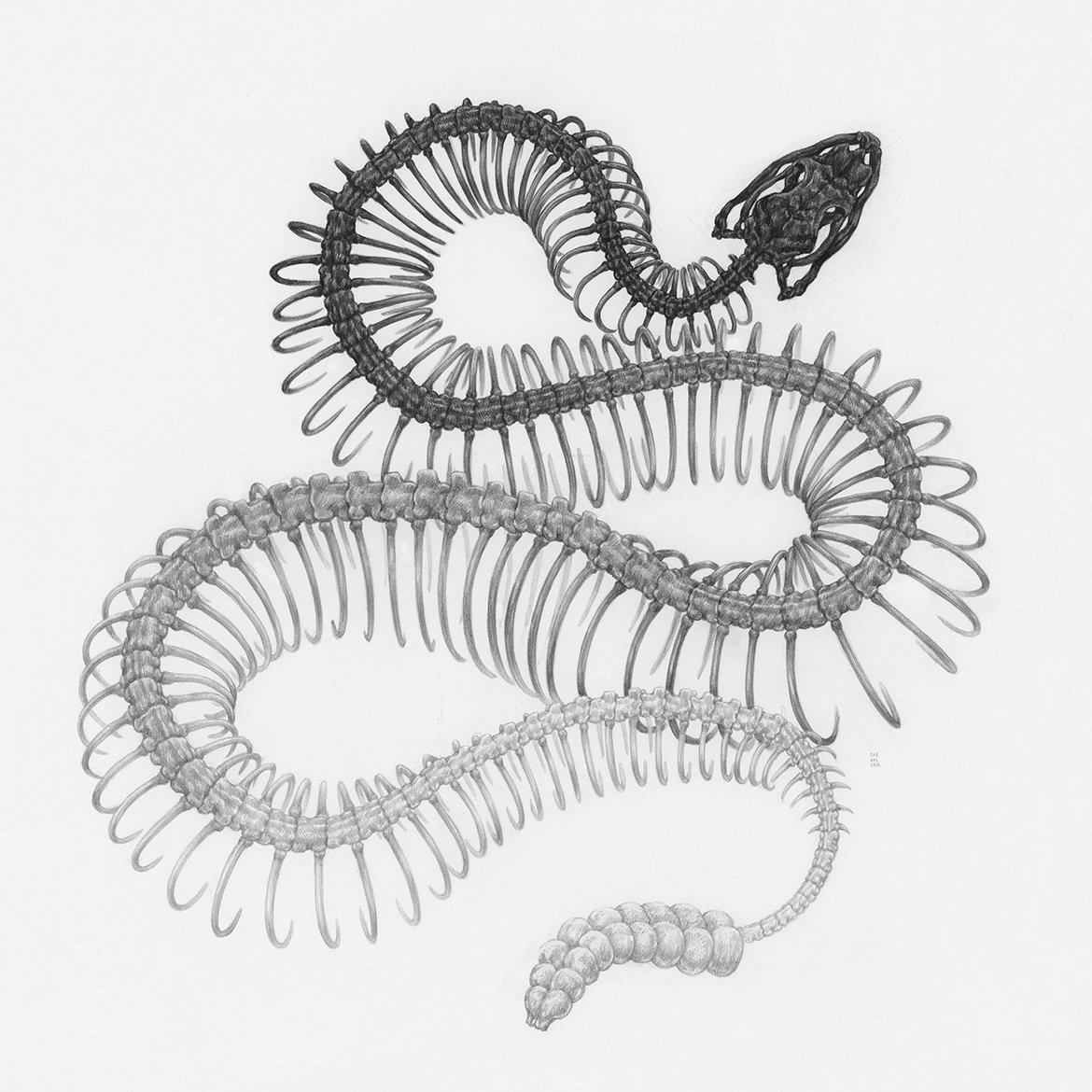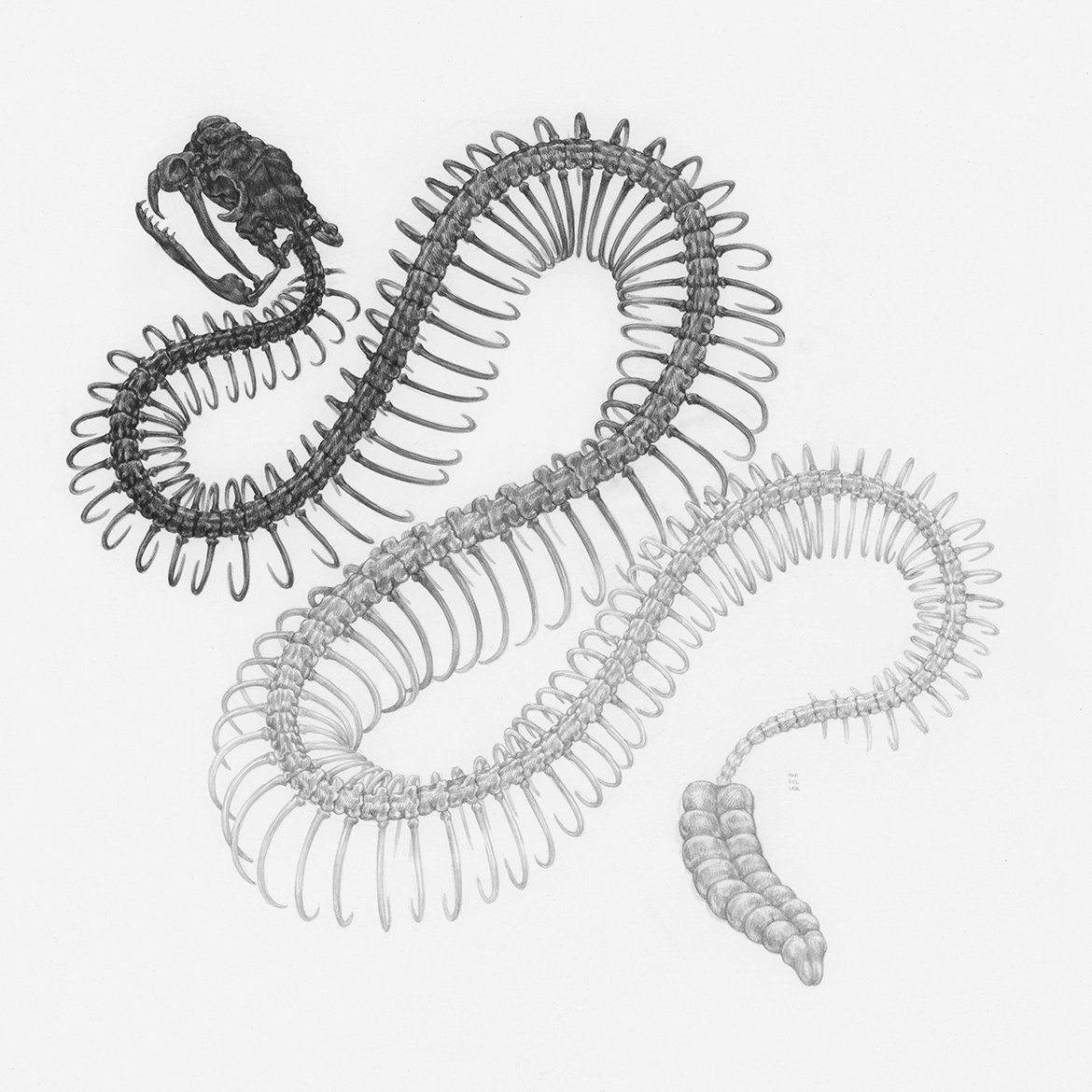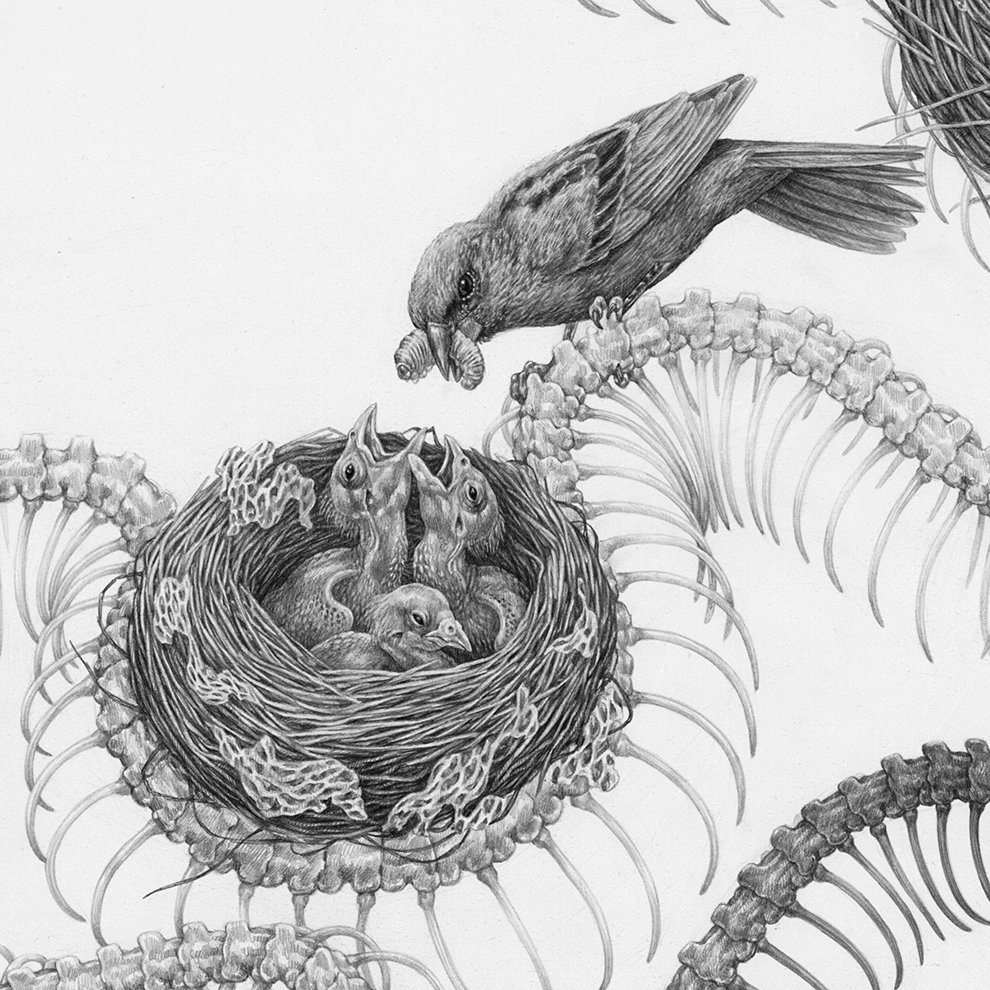SCALE & BONE
My deep fascination with snakes began in 2019, with my series exploring the biodiversity of Zion National Park. One of the drawings in my ‘Zion’ show, which I also reproduced as a color poster, features snakes that can be found within the park. I noticed both at the opening for this show and at events where this poster was sold that this drawing stirred up particularly strong reactions in viewers. Many loved snakes so much that upon seeing the drawing they immediately wanted to share their encounters with snakes, both in the wild and as pets. Others were so afraid of snakes that even a drawing of snakes made them uncomfortable, and the voicing of this discomfort was an almost involuntary reaction. After these experiences, I decided to do a more in depth exploration of these polarizing creatures, finding visual language that celebrates their intricate beauty, their important roles in ecosystems, and the fragile nature of species now at risk of steep decline and extinction.
The ten species of snake represented in this show have either been designated as Threatened or Endangered under the US Endangered Species Act, have been identified by the Center for Biological Diversity as worthy of federal protection, or have already (and perhaps prematurely) been declared extinct.
Diptych I | Always
The skeletons of two at-risk rattlesnakes coil, their rattles and fangs indicating their defensive powers.
New Mexican Ridge-nosed Rattlesnake
14” x 14” (35.6 x 35.6 cm)
Designated as Threatened at the Federal Level, this small, elusive rattlesnake can be found in New Mexico’s Animas and Peloncillo Mountains.
Eastern Massasauga
14” x 14” (35.6 x 35.6 cm)
Designated as Threatened at the Federal Level, this unusually aquatic rattlesnake can be found in northeastern Missouri, and from southern Iowa to western New York and southern Ontario.
Diptych II | Memento Mori
Butterflies, symbols of mortality, pool on garter snake skeletons, representing two at-risk species. The butterflies selected for these drawings are common, with ranges extending over much of the United States, a nod to the homogenization of our ecosystems as fragile species with limited ranges are lost.
Giant Garter Snake and Pipevine Swallowtail
14” x 14” (35.6 x 35.6 cm)
The Threatened Giant Garter Snake is found in the Sacramento and San Joaquin Valleys in California.
San Francisco Garter and Cabbage White
14” x 14” (35.6 x 35.6 cm)
The San Francisco Snake is designated as Endangered at the Federal Level and is found primarily in San Mateo County, straying into the northern limits of Santa Cruz County.
Diptych III | Where We Once Lived
Copperbelly Water Snake
14” x 14” (35.6 x 35.6 cm) Click Here to Purchase via Antler Gallery
The Copperbelly Water Snake is found in two distinct populations: a southern segment in Kentucky and Illinois, and a northern segment in Michigan, Ohio and Indiana. The northern population segment is listed as Threatened at the Federal level. Habitat loss and fragmentation have led to this species’ decline.
Tucson Shovel Nosed Snake and Desert Hairy Scorpion
14” x 14” (35.6 x 35.6 cm)
The Tucson Shovel Nosed Snake is threatened by habitat loss in the Sonoran Desert. Once found in both the southwestern United States and northwestern Mexico, this snake species is now believed to only live in Pinal County, Arizona. The Tucson Shovel Nosed Snake was listed as a candidate species at the Federal level in 2010, but was delisted in 2014.
I used the nature app iNaturalist to find Research grade observations of this particular subspecies of snake. Most observations were concentrated around Arizona State Route 79. I looked at what other species were documented in this area to select the Desert Hairy Scorpion as a companion for this snake.
LONGLEAF PINE SERIES
About Longleaf Pine Forests
Longleaf Pine forests once covered 90 million acres in the Southeast, stretching from Virginia to Florida, and west into eastern Texas. Today, only three percent of the original forest remains, lost to hundreds of years of commercial logging, fire suppression, the conversion of forest to urban development and livestock grazing, and the replanting of forests with faster growing species of pine. These rich forests are dominated by their namesake Longleaf Pine, an evergreen conifer that grows 80 to 100 feet (24 to 30 meters) tall and has leaves that can grow up to 18 inches (46 centimeters) long. But there is much more to these forests than Pinus palustris; mature Longleaf Pine savannas can contain up to 40 species of plants, making them one of the most diverse plant communities on the globe. Even in their fragmented state, remaining stands of Longleaf Pine forest harbor almost 200 species of birds and hundreds of animal species. More than 30 of these species are endangered and threatened, including two species of snakes that have been designated as Threatened at the federal level: the Eastern Indigo Snake and Black Pine Snake. Although it has not yet received federal designation, the fate of the Eastern Diamondback Rattlesnake is inextricably linked to that of the Longleaf Pine ecosystem, and has declined with the loss of its habitat. The three pieces in this Longleaf Pine forest series explore these at-risk snakes and the species they share Longleaf Pine forests with.
Eastern Indigo
27.5” x 36” (69.9 x 91.4 cm)
Click Here to Purchase via Antler Gallery
A Threatened Eastern Indigo snake wraps itself around five species of pitcher plants, carnivorous plants that flourish in the pitcher plant bog microhabitats found through-out Longleaf Pine ecosystems.
Species
Eastern Indigo Snake Drymarchon Couperi
Pitcher plants, clockwise from top right:
Whitetop Pitcherplant Sarracenia leucophylla
Parrot Pitcherplant Sarracenia psittacina
Hooded Pitcherplant Sarracenia minor
Yellow Pitcherplant Sarracenia flava
Green Pitcherplant Sarracenia oreophila
Details
Eastern Diamondback Rattlesnake
34” x 43” (86.4 x 109.2 cm)
An Eastern Diamdondback Rattlesnake skeleton shelters fellow Longleaf Pine species, including an important prey species - a cottontail - and two Gopher Tortoises hatchlings. Gopher Tortoises dig burrows where rattlesnakes often seek shelter.
Species
Eastern Diamondback Rattlesnake Crotalus adamanteus
Longleaf Pine Pinus palustris
Eastern Cottontail Sylvilagus floridanus
Gopher Tortoise Gopherus polyphemus
Common Plants
Small Spreading Pogonia Cleistes bifaria
Bog Thistle Eryngium integrifolium
Sandswamp Whitetop Dichromena latifolia
Butterflies Common Buckeye Junonia coenia
Zebra Swallowtail Eurytides marcellus
Fiery Skipper Hylephila phyleus
Little Metalmark Calephelis virginiensis
Yucca Giant Skipper Megathymus yuccae
Details
Black Pine Snake
34” x 43” (86.4 x 109.2 cm)
Click Here to Purchase via Antler Gallery
Three species of birds that breed in Longleaf Pine forests and use snakeskin to construct their nests raise their young in the skeleton of a Threatened Black Pine Snake.
Species
Black Pine Snake Pituophis melanoleucus Iodingi
Carolina wren Thryothorus ludovicianus
Great Crested Flycatcher Myiarchus crinitus
Blue Grosbeak Passerina caerulea
Details
Are We Ghosts
27.5” x 36” (69.9 x 91.4 cm)
The South Florida Rainbow Snake, known from only three specimens and last collected in 1952, was declared extinct by the U. S. Fish and Wildlife Service in 2011. Unconfirmed sightings of the elusive nocturnal snake have led some scientists and advocates to argue that this designation was assigned too soon, and a $500 reward has been put up for documentation of its existence.
Common Water Hyacinth has been observed in Fisheating Creek, the only known home of the South Florida Rainbow Snake. The invasive Water Hyacinth grows at an incredible rate, choking waterways and shading out native vegetation.
Species
South Florida Rainbow Snake Farancia erytrogramma seminola
Common Water Hyacinth Pontederia crassipes
Bald Cypress Taxodium distichum
Details





















